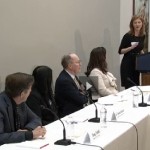By Kristen A. Graham
The Philadelphia Inquirer
February 17, 2015
Just days before the fate of 39 new charter-school applications is decided, pressure on the School Reform Commission is building from all sides.
Top state Senate Republicans have sent Chairman Bill Green a letter saying they were “confident” that the SRC would approve strong charter schools.
The letter, obtained by The Inquirer and sent Friday by Senate President Pro Tempore Joe Scarnati (R., Jefferson), Majority Leader Jake Corman (R., Centre), and Education Committee Chairman Lloyd Smucker (R., Lancaster), said the leaders were “hopeful that the SRC will approve these qualified charter schools in the very near future.”
The SRC is scheduled to vote on the charter applications, the first new proposals considered in seven years, on Wednesday. If the commission approves 15,000 new seats, the six-year price to the financially troubled school system could be close to $500 million, district officials say.
A powerful education nonprofit group has offered the district $35 million – $25 million of it to offset new charter costs – but the SRC has given no indication whether it intends to accept the controversial gift. The senators, however, hailed the offer from the Philadelphia School Partnership, which is bankrolled by donors who have not been named.
The senators said they would also work toward “meaningful public pension reform” that would help the SRC, and changes to the traditional teacher seniority structure, which the SRC has already challenged.
Their “approve charters” message echoes one sent publicly by House Speaker Mike Turzai (R., Allegheny), who has spent significant time in Philadelphia recently. Turzai has said the SRC should approve between 16 and 27 charters.
All the lawmakers have reminded the SRC that they helped get a $2-per-pack cigarette tax passed last summer. That legislation included language that required the commission to consider new charter applications. But others have sent the opposite message.
Gov. Wolf, sources said, has told the SRC he wants it to approve no new charters because the School District cannot afford them.
Asked about the governor’s position on charter schools, Wolf’s press secretary, Jeffrey Sheridan, wrote in an e-mail: “The Wolf administration believes the SRC must stabilize, not worsen, the district’s finances. It cannot spend money it does not have for new charters or other expenses. It is past time we reaffirm our commitment to high quality public education for all children.”
Caught between two powerful and diametrically opposed camps, what is the SRC to do? “Regardless of the political pressure from anybody,” Green said, “I think this SRC has demonstrated that it is going to call balls and strikes in accordance with the law. We’re simply going to follow the law.”
Charter-school law, Green said, holds that if a provider meets all requirements, “it appears to require us to approve applications.”
In the past, financial concerns have made the commission hold off on approving new stand-alone charter schools – though it has more than doubled the charter-school population through expansions and turning district schools over to charter-school operators.
But the legislation that allowed the cigarette tax, which gave the district the cash it needed to open schools on time in September, also required the SRC to open applications for new charters, and gave applicants turned down by the commission the right to appeal to the state.
District officials have estimated that every new charter seat costs the district $7,000. For a district already projecting an $80 million deficit for the 2015-16 school year, the prospect of sending more children to charter schools is fiscally daunting.
Green, however, stressed that in the case of approving charters, only state regulations could be considered.
“We don’t get to make the law,” he said. “We have to comply with the law.”
A former SRC member known for watching district finances closely has also weighed in on the commission’s coming decision.
Joseph Dworetzky, who served from 2009 to 2014, said plainly in a letter to the SRC that “the district cannot afford new charters.” New charter schools, he said, are “extraordinarily expensive.” The SRC is obliged to consider the impact of new charter-school seats on current district students, Dworetzky said.
“That $7,000-per-student-per-year loss is not a ‘paper loss,'” Dworetzky wrote. “The district must actually fund it and the only place where most of those funds can come from is by way of further reductions to the instructional services that benefit the remaining students. That isn’t fair and it isn’t equitable.”
Dworetzky wished his former colleagues well.
“You are in a hot seat on this decision,” he wrote, “and will certainly make many people unhappy, no matter how you decide.”











